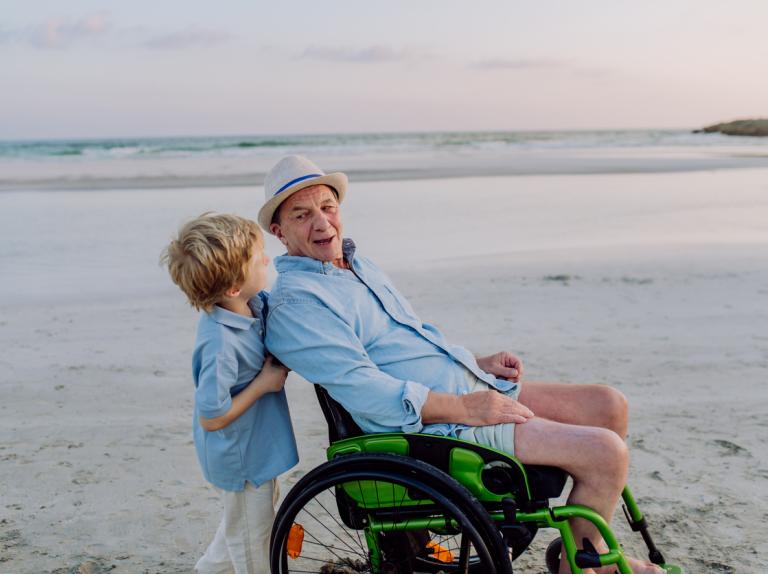
Resources: Destination organizations and industry partners can enhance customer experiences, foster community relationships, and promote workplace inclusivity through thoughtful accessibility strategies. Key practices include collaborative expertise, intentional funding, and holistic organizational integration. With recent data findings and global best practices, learn more about how you can get started.
The World Health Organization (WHO) estimates that 1.3 billion people, or 16% of the global population, live with disabilities1. These disabilities can be both seen and unseen: from mobility limitations to visual or auditory impairments, and neurocognitive differences.
The well-being of people with disabilities can be greatly influenced by the environments they live in. For example, this population can experience barriers in their health systems or because of local policies and their built environment. Poverty and social exclusion, extending to both employment and education, may also exist, ultimately creating inequities.
WHO indicates that “disability inclusion is critical to achieving the Sustainable Development Goals and global health priorities to achieve health for all.” As such, Destinations International has placed accessibility within its Social Inclusion Framework: a strategic, people-centric approach to foster community trust and vitality and impact vibrant economic growth.
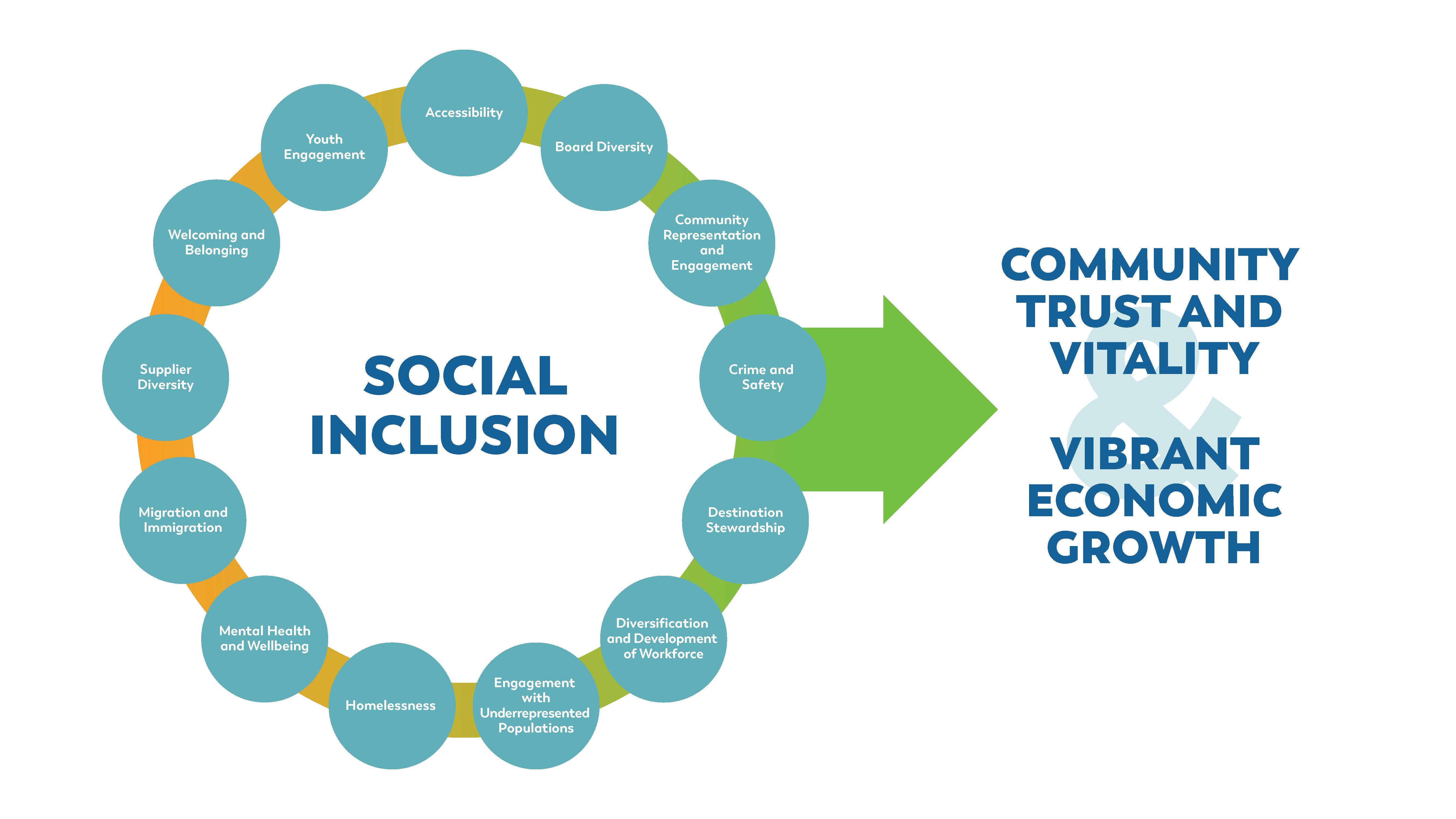
The opportunity for accessibility
Addressing accessibility is a significant opportunity within the travel and tourism industry. By developing and implementing accessibility strategies, destination organizations and industry partners can heavily influence this underserved population and champion inclusion in three ways:
- By embedding accessibility into customer experiences. From initial travel research to visitation, leisure and business travelers with disabilities face many barriers when traveling. In the US alone, this represents 26% of the total population.2 MMGY’s Portrait of Travelers with Disabilities™: Mobility and Accessibility found that US travelers with mobility disabilities spend $58.2 billion per year on travel, and travel with a similar frequency as those without mobility issues.3
- By engaging community partners. Developing relationships with accessibility-focused groups can integrate an organization with its community, aligning to Community Shared Value.
- By examining workplace practices. Embedding accessible-friendly practices into workforce and operations allows employees with disabilities to thrive and influences inclusion, innovation, and performance.
But where does a strategy begin? And what does “good” look like?
Let’s start with some data
As destinations approach accessibility strategies differently, data can offer valuable insights into the state of accessibility in our industry – and in our organizations.
Destinations International’s 2023 Social Inclusion Survey found that 22% of responding industry partners (n=106) and 16% of respondent destination organization employees (n=406) identify as persons with disabilities. Of the latter, a notable 14% of entry-level employees indicated being neurodiverse.
Destination International’s Social Impact Assessment Tool examines accessibility through the design and implementation of products, services, environments, and information. From its most recent data collection of nearly 100 destinations, the overall "maturity" of responding destinations is 34% with a best practice ranging from 25-48%.
Results indicate that destinations are most "advanced” in marketing their customer experiences: roughly 40% of destinations provide information to travelers with disabilities on their websites. Yet, destinations are not addressing the experiences of disabled people upon visitation, as 42% do not provide customer-facing training for their staff and 61% do not provide training for their members and partners to understand or address the needs of people with seen and unseen disabilities.

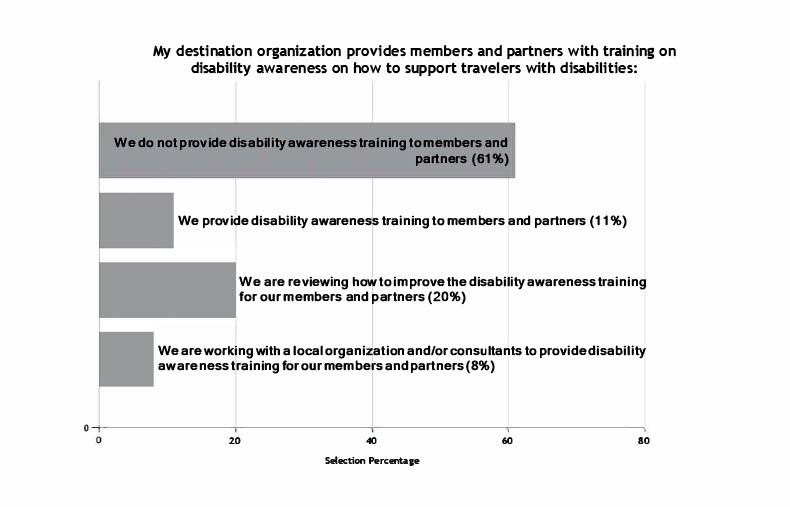
As with any transformative strategy, change must start at the top with board and executive leadership support. Data shows that a little more than two-thirds of respondents do not have an individual responsible for an accessible travel strategy, do not have a dedicated budget, nor have they conducted a foundational audit of member or partner offerings. One-third of respondents do not have a documented accessible travel vision and strategy with short- and long-term goals.

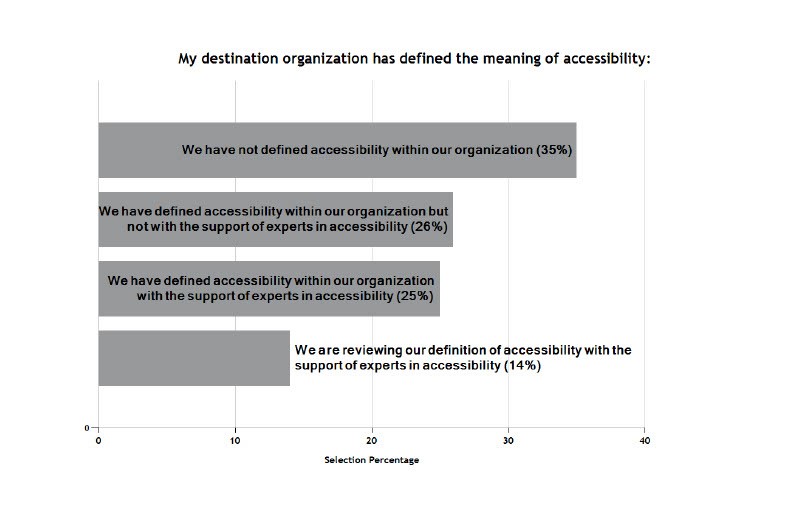
Destinations International encourages its members to take an intentional approach to shaping their accessibility strategy. As every destination is unique, this strategy understandably cannot be a “one-size-fits-all approach.” However, destinations can leverage best practices from those whose strategies are underway.
Shape your strategy with subject matter expertise.
In developing their three-year strategic plan, Experience Kissimmee made a conscious decision to prioritize accessibility. “We wanted to plant a flag and set the table, highlighting our principles of sustainability, partnership, and social impact,” Jason Holic, Sr. Vice President of Operations & Community Engagement, shared. By aligning to existing co-ops at the state level, Experience Kissimmee was not only able to tap into available funds, but establish relationships with a strong accessibility-focused community.
At Experience Columbus, their strategy started organically. Through requests from existing and potential visitors, a member of the Experience Columbus team built out an extensive list of accessibility resources. The team realized the significance of this work and turned to their community. They established a partnership with Rosemarie Rosetti, a local consultant who navigates their city as a person with a mobility disability. Together, this shaped the creation of their Accessibility Guide.
Similarly, Visit Myrtle Beach reflected on what they could do as a destination to be more inclusive and decided to look at their community. This research brought them to Champion Autism Network (CAN), an organization in the Myrtle Beach area that had been doing work for six or seven years to provide resources and training around sensory-friendly travel. A member of their team had already been training frontline workers to help them recognize and accommodate disabilities related to autism. Recognizing CAN’s expertise and progress, Visit Myrtle Beach approached this organization to develop a collaborative relationship.
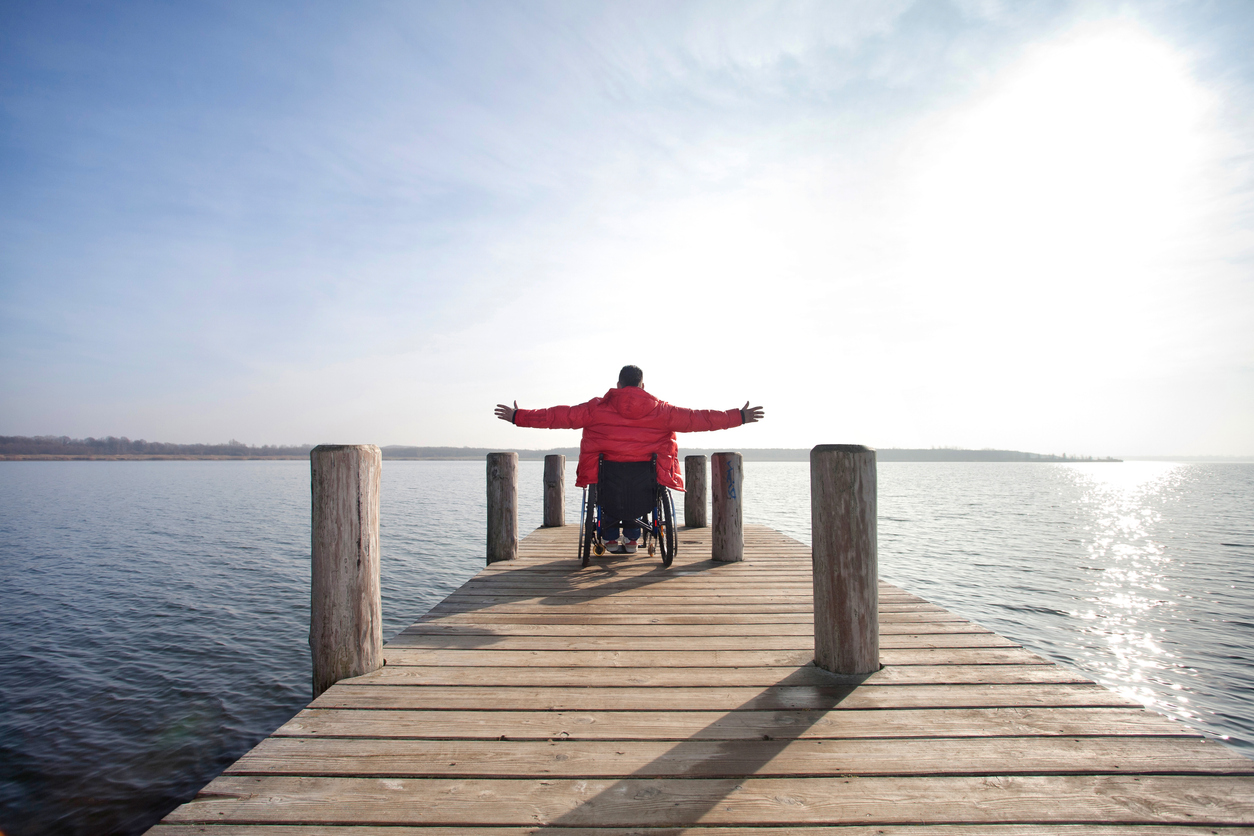
Exploring grant opportunities becomes a strategic move to support accessibility initiatives.
A strategic approach to funding has been a huge factor in the success of Travel Lane County. The regional destination, which has access to grant funding through Travel Oregon, aligned over $70,000 in funding to their Loop Lane project, a targeted initiative to better support visitors with hearing loss. The funds subsidized hearing loop installation costs by 80% for tourism members and led to more than 35 hotels and 5 venues in the region now having hearing- assisted devices. Connor Nolan, Destination Development Manager who joined Travel Lane County for this initiative, remarks on its success: “It’s been such a great advocacy piece for hearing loss audience.” Like other destinations, the genesis of the Loop Lane project started from an existing program in the community, the John G. Shedd Institute for the Arts. When the destination recognized the opportunity to impact the tourism community at large, it formed an advocacy group dedicated to addressing hearing loss needs broadly.
As the throughline for destination organizations across the state of Michigan, the Michigan Association of Convention and Visitors Bureaus (MACVB) orchestrates an annual conference to provide education and enablement on accessibility, sustainability and diversity, equity, and inclusion. Destinations are encouraged to apply to grants offered by the state and must report efforts to drive inclusivity within their communities annually.
Ottawa Tourism’s destination development fund offers members financial resources to support strategic needs that impact the community. Given the long-term nature of their developing accessibility plan, Ottawa Tourism opted to allocate resources from the fund to a distinctive accessibility tourism fund. This allowed them to offer grants of $10,000 or $25,000 to destination members who had specific accessibility projects in mind, like signage, improving their bathrooms, and paving. In creating this accessibility tourism fund, it helped Ottawa Tourism better understand what members need. It showed Destination Development Manager Julia Cosentino that members have plans and desire to do projects and has heightened engagement and deepened relationships with the member community.
Embedding accessibility considerations throughout the organization ensures a comprehensive and sustainable approach.
Destinations recognize that championing accessibility is not a siloed endeavor. Rather should weave throughout the organization to align outcomes and drive impact.
As the destination organization for Ireland, Fáilte Ireland approaches accessibility through two lenses: internal design framework and external strategy. Its newly developed inclusion team serves as an internal consultant group to guide their organization and engages with its members to lead implementations and facilitate training on customer service and digital accessibility design. By investing in its own subject matter expertise and ability to influence impact across the country, Fáilte Ireland aims to be among the top three most accessible destinations in the world.
Both Travel Lane County and Ottawa Tourism have destination development teams. While these teams serve as program managers to progress accessibility-related projects, their leadership ensures that all employees recognize and consider the importance of accessibility within their work. To Connor Nolan, it’s made a difference. “Rather than being the individual that owns this work and tells different departments what we do, accessibility is embraced by everyone internally. It’s allowed us to create a stronger value chain, and ultimately helps everyone understanding how they can play their role in fostering accessibility.”
Investing in Accessibility Leads to Inclusive Returns
This is Athens established a partnership with Me Alla Matia, a Greek-based NGO whose vision is to eliminate underrepresentation of people with disabilities. Translating to “with a different point of view,” Me Alla Matia orchestrated focus groups of people with disabilities to guide the creation of accessible-friendly city guides. This input shaped the creation of four itineraries for mobility and visually impaired individuals, each with a step-by-step text guide and assistive interactive maps. Their community has embraced these itineraries, as local volunteers serve as “walking guides” to provide an authentic visitor experience. This is Athens continues to have constant communication with Me Alla Matia to ensure their strategy is evolving and ever inclusive.
Upon releasing their Accessibility Guide, Experience Columbus exceeded their goal for 5,000 impressions upon launch. The guide has resonated strongly in-market, bringing the tourism community together and deepening relationships with members. The Guide has served as a springboard to support expanded needs of the accessibility community, like universal changing tables, and serves as a key component for media pitches.
Visit Myrtle Beach’s partnership with the Champion Autism Network has made a tremendous impact on the destination. More than 2,500 frontline employees have been trained to engage with neurodiverse visitors. Alongside these efforts, Visit Myrtle Beach has taken a creative approach through branded entertainment. The destination will soon launch a six-part miniseries documenting three families with kids on the spectrum as they experience Myrtle Beach. Their soon-to-publish children’s book, “Splish, Splash, Squawk! Finding Joy in a Sensory-Friendly Vacation” aims to inspire families as they consider travel.

Lessons Learned and Advice
Creating your accessibility strategy can understandably feel overwhelming. Consider lessons learned and advice from destinations underway to guide your approach.
1. Examine your surroundings.
As you go about your day to day, pay attention to the built environment of your destination. Reflect on what accommodations currently exist and what infrastructure can be improved upon for different types of abilities.
2. Executive leadership and board support goes a long way.
Destinations recognize the commitment of their leadership team is imperative for success. Experience Columbus has fantastic support from their leadership team, who made sure that resources would be available, despite not budgeting for them. Failte Ireland’s executive leadership and vision has opened doors to liaising with their Minister of Tourism, allowing the organization to influence future policy.
3. Leverage training to deepen understanding.
While training isn’t a required “first step” to get started, it is important for destination staff to understand experiences, terminology, and servicing visitors. By going through training, destination staff can then better engage and align with their stakeholders.
4. Be open to new paths.
Be receptive to new insights around traveler needs. Information and feedback from accommodations, attractions, and influencers with disabilities can guide future programming or initiatives.
To learn more about best practices, measure your accessibility maturity, or share your own approach to accessibility, reach out to [email protected]. Thank you to the many DI members whose testimonials shaped this report.


